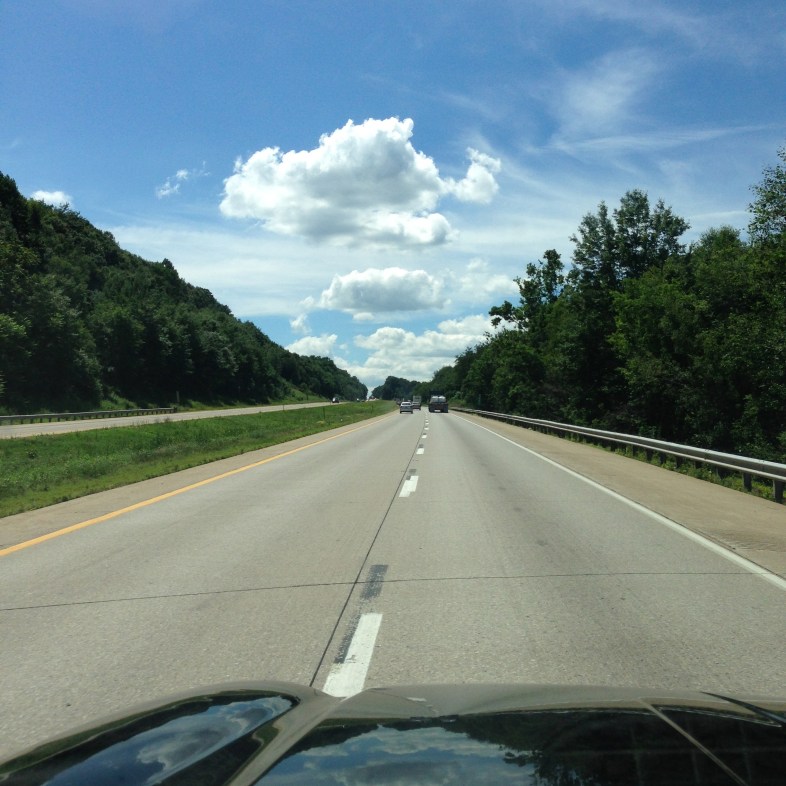24 Things All Licensed Drivers Should Master


“I’m a really good driver,” says every driver ever. However, if every person behind the wheel was really as good as they claimed (and obeyed all of the traffic rules and regulations) there wouldn’t have been a reported 3.8 million injuries related to traffic collisions in 2013, according to the National Safety Council. Keep in mind, that statistic only counted injuries that required medical attention, not all accidents. So, before we start our car and rush off to the next destination that we’re already late for, let’s master some of the basic driving concepts first.
1. Focusing Only On The Road Ahead. I’m calling you out person applying your makeup in the car. I’m not going to lie, it’s impressive that you can put a pencil in your eye, even more so while driving a car, but it’s not safe for you or anyone else. There are about 450,000 accidents a year caused by drivers applying cosmetics, according to The Daily Mail. And person reading the newspaper and steering, are you kidding me? Listen to NPR or AM radio. If you live in New York, all you have to do is give 1010 WINS 22 minutes and they’ll give you the world.
2. Parking Within The Lines. There are two lines. Your job is to place your car between the two lines. That’s it. No more, no less.
3. Knowing When You Shouldn’t Drive. If you’re tired or have had too much to drink, know your limits. Have a friend drive you home, call a car service, or sleep in your car. Every day, almost 30 people in the United States die in motor vehicle crashes that involve an alcohol-impaired driver, according to the Centers for Disease Control and Prevention. That comes out to about one death every 51 minutes.
4. Maintaining A Safe Driving Distance. Unless it’s the Daytona 500 or you’re an actor in The Fast and the Furious franchise, there’s no reason to tailgate. It’s just going to annoy the driver in front of you and put extra pressure on your decision-making skills should that driver stop short. Take it easy, Ricky Bobby.
5. Mall Driving. Mall parking lots may be the most dangerous place on earth. If you don’t believe me, go drive at a mall. You have to worry about a lot more than the delinquents hanging out there. Shoppers are so excited for sales and convenient parking spaces that they’re not paying attention to anything else.
6. Remaining Calm In Tense Situations. If a driver cuts you off, it’s natural to feel a rush of anger, but there’s no need to chase the driver down or engage in a verbal or physical fight. Avoid road rage at all costs, unless you’re The Rock and know you’ll win any altercation. But in all seriousness, can’t we all just get along?
7. Entering A Freeway Or Highway. The key to merging is figuring out the current flow of traffic you’re entering into and then adjusting accordingly. Unless you’re driving a Lamborghini, Bugatti, or any other car that goes 0-to-60 in under three seconds, don’t stop at the end of the on-ramp. You’re just going to make it that much more difficult for you to actually enter the freeway or highway and will jam up all of the other cars behind you.
8. Understanding There’s Always Another Exit. You’re driving in the far left lane and the GPS tells you to exit right 250 feet ahead. Traffic is heavy, making it difficult for you to jet across. What should you do? You have a brain. Use it. Don’t cut other drivers off to try and make the exit. Slowly merge and make your way over to the right lane and take the next available exit. Your GPS will be able to guide you from there, even if it adds a couple of extra minutes to your trip. And never, ever, ever drive in reverse on a highway so you can get off at the exit you originally missed.
9. Knowing Where All Of The Controls In Your Car Are Without Looking. One of the first things my grandfather made my dad do when he received his learner’s permit was buckle up, start the car, and then with the car still in park, turn the radio on. My dad looked down to adjust the settings. “Do it again,” my grandpa said. “And keep one hand on the wheel, your eyes on the road, and use your free hand to search for the stations.” It’s basically as close as it gets to a driving lesson with Mr. Miyagi.
10. The Art Of The Drive-Thru. It really is an art. You have to maintain an appropriate distance to the PA system so you’re not yelling, turn the corner without scratching the side of your car, and make sure you’re close enough to the cashier so you can pay for your meal and receive your food and change without having to put your car in park and stand up outside the drive-thru window to make the transaction happen. Otherwise, you’ll just look silly.
11. Using Your Phone In The Car. Keep your hands at 10 and 2. OK, fine. We’ll settle for you just keeping your hands on the wheel. That means don’t play with your phone to read an e-mail or text while you’re driving. If you have a hands-free system installed in your car, which you should if you do a lot of talking in your car, don’t flail your arms when you’re delivering a passionate speech to a lover, colleague, or family member. 26 percent of the nation’s car accidents are caused by the use of cell phones, according to the National Safety Council. Keep your eyes on the road and hands on the wheel at all times. The text, e-mail, or call can wait.
12. Having Emergency Contacts At The Ready. It would be beneficial to know how to change a flat tire or jump-start your car, but if you’ve never learned or aren’t interested in learning, at least know the number for roadside assistance and have a plan in place in case your car breaks down. You don’t want to be figuring it out in the heat of the moment.
13. Maintaining Your Vehicle. Know what’s under your hood and how to check your car’s gauges. Is the oil level safe? Is the tire pressure the correct amount? If you don’t know how to check those things yourself, at least know how many miles you’ve driven since your last oil change and the necessary tire pressure, which you can find in your car’s manual. Many oil change businesses inspect your car and check the tires, fluids, filters, etc. as part of the service. If you’re not doing the maintenance yourself, at least have someone else do it.
14. Using The Horn Only When Necessary. When you’re waiting outside your friend’s house, park and call your friend to come out. Or go to the door and ring the bell. Don’t double park and lay on the horn for your friend to run out, while blocking the flow of traffic and disrupting the neighbors. The only time you should be honking your horn when you’re driving is if there’s a situation that you want to get another driver’s attention to prevent an accident.
15. Understanding That Speeding Doesn’t Really Get You There That Much Quicker. If you don’t believe me, just look at this graph. Even if you can cut twenty minutes off of a long trip, is it worth it to risk getting a ticket? You’ll have to wait on the side of the road after being pulled over, which will probably take longer than the time you think you’re saving.
16. Gas Station Etiquette. If there are three gas pumps, go to the far or middle one to allow other people to fill up behind your vehicle. When you go to the closest one, you make it difficult for other cars to enter the gas station or fill up. Then the other drivers have to do maneuvers to get around you. Also, if you’ve finished pumping the gas and want to use the restroom or buy a snack inside, park your car. Don’t leave it blocking the gas pump when you’re not there.
17. Using Courtesy Hand Signals. Give that kind person who allowed you to cut in a little wave as a thank you. This way the driver receives positive reinforcement and will continue to allow cars to merge in. Other than that, keep your hand signals to yourself. There’s no need to flip the bird to another driver, even if you’re pissed off.
18. Yielding To Emergency Vehicles. If you hear a siren blaring, don’t speed up to beat the ambulance, fire truck, or cop car so you won’t have to wait. Stop and let the emergency vehicle pass. Then you can go on your merry way.
19. Understanding Your Surroundings. If you’re driving in a residential area and a ball rolls into the road, slow down and prepare to stop. Don’t speed around the ball because there may very well be a little kid running into the road after it. Be smart, especially in residential areas with lots of kids around.
20. Driving In The Rain Or Snow. Whatever speed you think is safe to operate your car at, go five-to-ten miles per hour slower than that when there’s inclement weather. There’s no need to rush around, especially when you’re having trouble seeing your surroundings and the pavement in front of you.
21. Knowing To Never Stop On Railroad Tracks Or Go Around The Gates. About every 90 minutes a vehicle and train collide in the United States, according to SafeNY. You’re also 30 times more likely to die in a crash with a train than with another motor vehicle. If you don’t see or hear a train coming, it doesn’t mean that you’re safe to go around the gates. Be patient and wait until you can safely drive over the tracks. Remember that it takes trains much longer to stop than automobiles.
22. Respecting School and Construction Zone Speed Limits. Fine, a speed zone does sound like a stretch of road that you should be able to speed with your car, not have to reduce the speed of your car. But that’s not the case. When you enter a speed zone, slow down. And watch out for children and crossing guards in school zones and workers in construction zones.
23. Actually Stopping At Stop Signs. If you see a bright red octagon sign with four bold letters that read: “STOP” it’s not a recommendation. It’s telling you to stop your vehicle. Not roll through slowly or continue on your way since you “know the neighborhood” as I’ve heard some people say as a way to rationalize not stopping when they’re supposed to. If you can’t comprehend the simple words, what happens with the more difficult ones?
24. The Fact That You Control Your Car. When it comes to driving and operating your vehicle, you make all of the final decisions. If the car behind you in the turn lane honks and wants you to make a turn with cars speeding at you, it’s up to you to decide whether it’s safe to proceed or not. Don’t forget that. You are responsible, and will be held responsible, for all of your actions in the car.
If you’ve mastered all of the things on this list and consistently follow the rules of the road, you should be proud of yourself. You’re making an effort to lower the number of nearly 1.3 million people who die in road crashes each year (an average of 3,287 deaths a day), according to the Association For Safe International Road Travel. There’s no better day to start taking control of our vehicles and paying more attention while we’re on the road than today. ![]()




